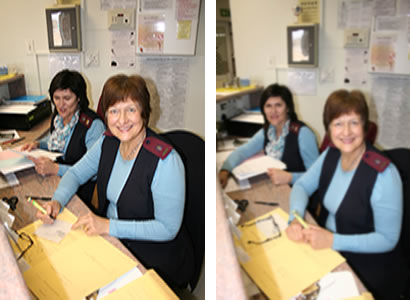What is a cataract?
It is when a clear lens of the eye becomes cloudy, opaque and discoloured, causing blurred vision.

Normal vsion Vision if the patient has a cataract
Where is the normal lens located?
Humans are born with a clear lens. This lens is positioned immediately behind the iris of the eye. It is suspended with zonular fibres for the full 360 degrees around the lens. These fibres keep the lens in position and fixed to the ciliary body behind the iris of the eye.
Is a cataract something that grows?
No, there is nothing that grows. It is a natural process that can occur with aging when the clear lens becomes cloudy and discoloured. This cloudy and discoloured lens influences the amount of light flowing into the eye, causing hazy or blurred vision.
What does cataract surgery entail?
During the operation the cloudy lens is removed and replaced with a clear plastic lens.
Types of catarct surgery:
Phaco
A small incision is made on the side of the cornea, the clear, dome-shaped surface that covers the front of the eye. Your doctor inserts a tiny probe into the eye. This device emits ultrasound waves that soften and break up the lens so that it can be removed by suction.
MSICS
Your doctor makes a longer incision on the side of the cornea and removes the cloudy core of the lens in one piece. The rest of the lens is removed by suction.
FLACS
Laser-assisted cataract surgery is the latest and most advanced method of performing cataract surgery. Many ophthalmologists prefer laser cataract surgery over traditional cataract surgery to break up the cataract.
After the natural lens has been removed, it is replaced by an artificial lens, called an intraocular lens (IOL). An IOL is a clear, plastic lens that requires no care and becomes a permanent part of your eye. Light is focused clearly by the new IOL onto the retina, improving your vision. You will not feel or see the new lens.
How long will the new lens last?
The new lens is made of acrylic [a plastic derivative] or even silicone and will outlive any human being. Once a new lens is implanted, a cataract will not reoccur. Cells may form on the capsule behind the new lens and can easily be removed in the consulting rooms with a YAG laser.
When is the right time for surgery?
When the patients’ vision becomes blurred or hazy and has an influence on his/her quality of life. Unoperated cataracts will become progressively worse and will eventually cause blindness.
Must I get spectacles after cataract surgery?
Implantation of a monofocal (standard) intraocular lens (IOL) will require you to visit an optometrist six weeks after surgery, in order to test your eyes for spectacles. However, implantation of a multifocal intraocular lens may lead to 100% spectacle independence and good far and near vision.
What is the difference between a multifocal and monofocal IOL?
A multifocal lens has both a distance and near focus area on the same lens, like bifocal glasses. This enables a patient to achieve a full range of vision with improved image quality, reducing the need for spectacles. However, some patients experience some disadvantages to a multifocal IOL, such as halos, glare or starbursts, especially with night time driving. Contrast sensitivity may also be affected.
In contrast, a monofocal lens has a fixed focal length, meaning focus is achieved at a single distance, either for distance vision or near vision, thereby, necessitating the need for spectacles after surgery.
What is monovision?
Monovision is where two different lenses are implanted, a distance vision lens in one eye and a near vision lens in the other eye to reduce the need for reading glasses. Many patients find this to be a very good option.
All of these options have advantages and potential disadvantages. Therefore, in order to make the best choice for your eyes, it is important to discuss the various options with your opthalmologist.



